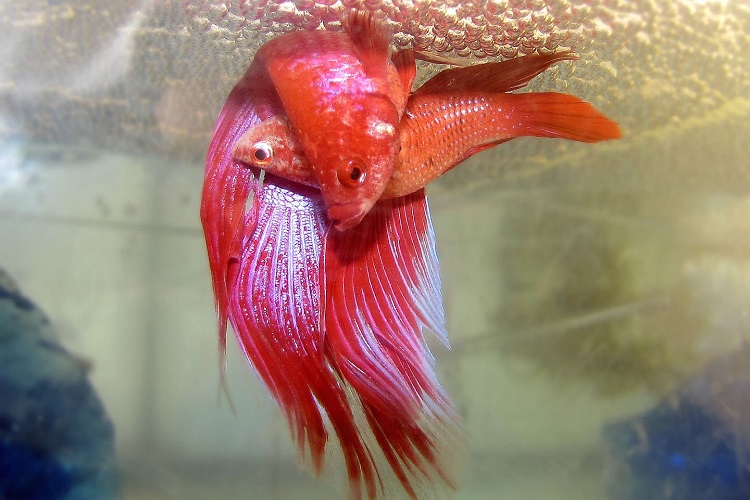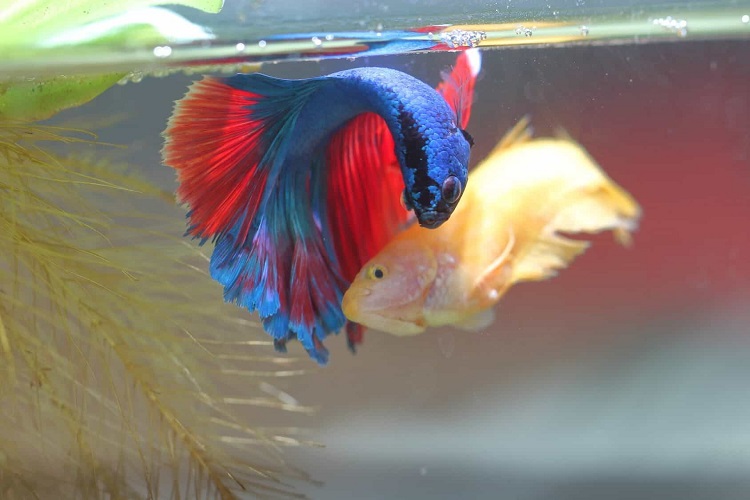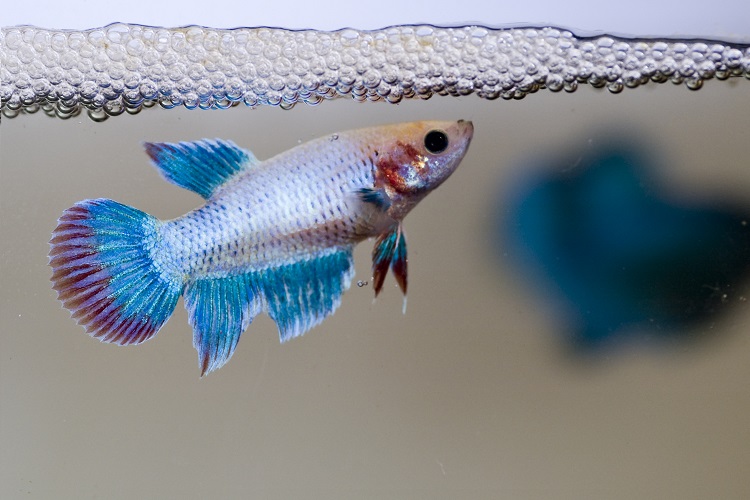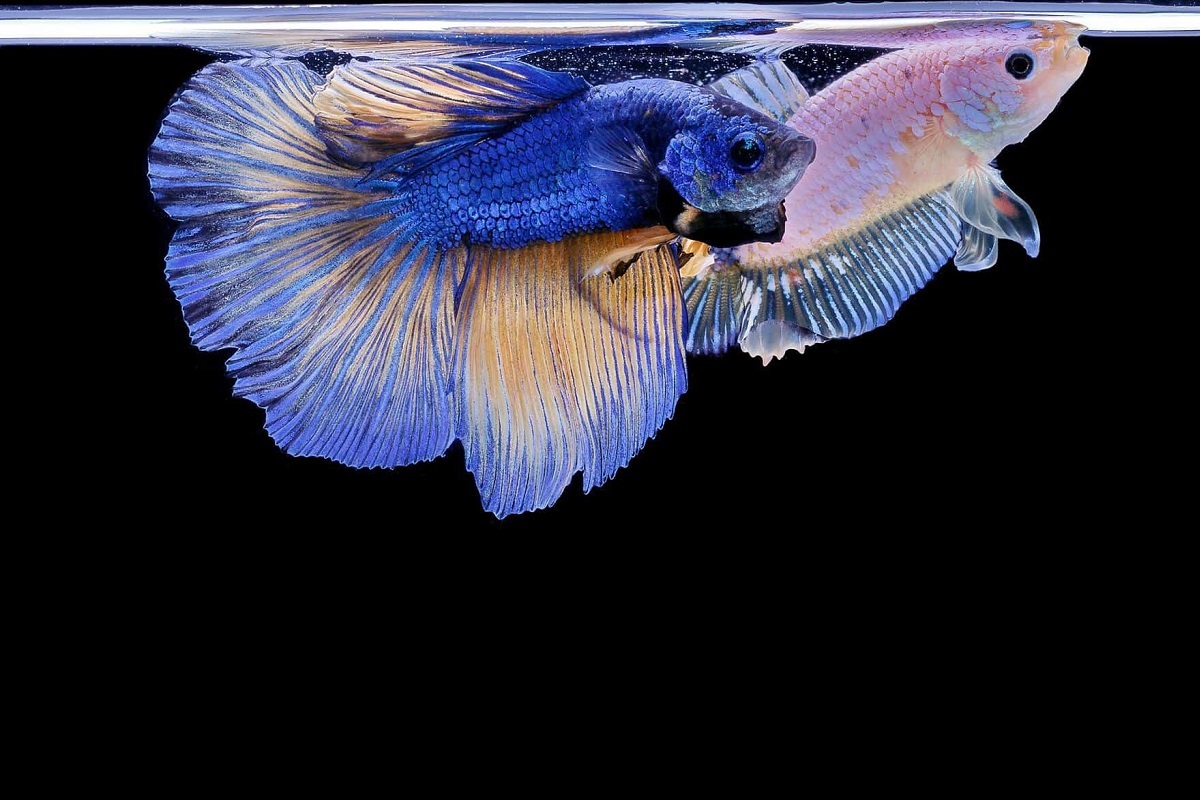Yes, in the sense that you need them together to mate but to cohabitate you will need a larger fish tank.
Because of the aggressive and territorial nature of Betta fish, having both sexes in a small tank can spell disaster, injury, or even death of your fish.
Betta fish also referred to as Siamese fighting fish, are beautiful, colorful fish that are popular in aquariums. They are native to Southeast Asia and were first found in the Mekong River basin. And they were then first imported to Europe in 1846.
Betta fish come in a variety of colors and patterns and can grow to be about 3 inches long. These fish are especially known for their long, flowing fins.
Betta fish prefer warm water and can live in both fresh and saltwater. They are carnivores and eat small insects, larvae, and crustaceans. Betta fish are very territorial and aggressive towards other Betta fish, which is why they are often kept alone in aquariums. That said, they are also easy to care for and can live in small spaces.
Betta fish are the preferred pets in home aquariums because of their beautiful fins and colors.
So how can you tell the male and female Betta apart?
Male Betta fish are typically more brightly colored than females.
Contents
Why are Betta Fish Valuable?
Betta fish are sold for their high value in the fish trading market. They can be bought for as low as $2 or as high as $30.
Betta fish are often bought by people who want to show them off in competitions. These fish are also used in research because of their ability to breathe air and live in water.
Putting A Male and Female Betta Together

Ideally, you’ll always need a male and a female of a certain species living together to have a complete reproductive ecosystem, right? For Betta fish, it’s both a yes and a no.
Male and female Betta fish can’t live together because they will fight to the death. Male Betta fish are aggressive and territorial towards other fish. They will attack any fish that comes near their territory, including female Betta fish.
When two male Bettas are put in the same tank, they will often start fighting for dominance. The fights can get so violent that the fish can kill each other. To keep your Betta Fish healthy and alive, it is best to keep them alone in their respective aquariums.
While it is possible for male and female Betta fish to live together, it is not recommended. Male and female Betta fish are very territorial and aggressive towards each other, which can result in injury or death.
If you do choose to keep male and female Betta fish together, be sure to provide a large enough aquarium with plenty of hiding places. You may also want to consider using a divider to separate the male and female Betta fish.
There are 2 kinds of arrangements in putting a male and female Betta fish together: short-term and long-term.
Short Term

Betta fish are beautiful, unique creatures that make mesmerizing pets. Though they are peaceful by nature, male and female bettas cannot cohabitate due to the males’ aggression towards the females.
However, sometimes short-term arrangements must be made, such as when cleaning the other’s tank. In these cases, it is best to only do so for a few hours and to monitor signs of aggressiveness.
Betta fish are usually quite docile, but given the right circumstances, they can become aggressive. If you see any signs of aggression, it is best to separate the fish immediately.
With proper care and monitoring, temporary arrangements between male and female betta fish can be made without incident.
Long Term
While it is highly discouraged, it is possible only if you have a large enough tank to house the male and female Betta fish together with a lot of accessories and hiding spots in case the other needs to get away for safety.
If you plan to keep 2 Bettas, then you need at least a 15-gallon tank with a 5 gallon incremental for every additional Betta you would like to have inside the tank.
Even if you think that your purpose is for breeding and that these two sexes would get along, it is highly unlikely and will require a careful process of introducing and timing the mating process.
If aggression occurs, it is best to separate the two fish to avoid injuries and waste of your investment.
Problems With Keeping Two Sexes Together

The biggest problem with keeping two sexes of Bettas together is the fact that the males are so aggressive towards the females. Male Betta Fish are territorial and will attack any fish that comes near their territory, regardless of the gender of the fish
Female Bettas, on the other hand, can co-exist as a “sorority” and live peacefully. This entails about 4 or 5 female Bettas in a tank. In some instances, adding a male into a Betta “sorority” tank can pacify the aggression of the male Betta.
However, aggression between the females may arise to assert dominance and attractiveness in vying for the attention of the male Betta when it is mating season.
Another problem with keeping two sexes of Bettas together is that the females can become stressed out and may not lay eggs.
Female Betta fish need a lot of peace to lay eggs properly. When they are stressed out, they may not lay eggs at all. If you want to breed your Bettas, it is best to keep them in separate tanks.
How to Introduce Females and Males Together
After being able to visibly see the other sex, an interested male Betta would begin creating a bubble nest at the surface of the tank/bowl to try and attract the female Betta.
You can choose to transfer the female Betta at this time to the breeding tank and she will inspect the bubble nest. An uninterested female Betta will either ignore or destroy the bubble nest.
At which time it is best to remove the fish and try again another time. The male Betta will choose to rebuild the nest however if she chooses to destroy the bubble nest once more, then they are not compatible for breeding.
A female Betta that accepts the offer to mate will be evident by her staying close to the nest without destroying it. Then the male Betta will begin to swim around her, sometimes chasing her around the tank.
The colors of these bettas often become more vivid during this mating phase as well as the flaring of the fins. This process may take up to three hours so avoid disturbing them or even feeding them during this time. However, make sure to be present during the process for quick action in case any of the two become overly aggressive to avoid any injuries.
The actual mating will occur when the male Betta embraces the female Betta as she will be turned over. As the eggs are released, the male Betta picks up the eggs and places them into the bubble nest. This entire process can be only for a few minutes or may continue for a few hours.
Once the mating process is done, it’s important to remove the female Betta fish from the breeding tank as it is highly likely for the male Betta fish to once again be aggressive and re-affirm its territorial dominance.
How Do I Breed My Betta?
Preparing the Betta for Breeding

From what we know of this species, you must set up a breeding tank. It is recommended that the tank be only filled with five inches of water and without substrate.
This should be a separate tank from the one that your Betta fish are currently living in. The breeding tank should have plenty of plants and hiding places. This will give the Betta fry somewhere to hide when they are firstborn.
Once you have set up the breeding tank, you’ll need to introduce the male Betta fish to the female Betta fish. The best way to do this is to place the male and female Betta fish in separate containers and then place those containers next to each other. The male and female Betta fish will then see each other and start the mating process.
From a technical standpoint, it’s vital to ensure that your breeding tank is of the right temperature for the breed (which is around 77 to 80 degrees Fahrenheit) and is filled with enough oxygen. The warm temperature helps with the stimulation of the need to reproduce for the Betta fish.
How Soon Do Betta Eggs Hatch?

Betta eggs will usually hatch in about 2 to 3 days, to which they will require the help of their male parent to survive. Once they can swim on their own, the male can be returned to its original habitat.
Provide plenty of food to your Betta fish fry with nutritious treats like vinegar eels, infusoria, and some micro worms.
Summary
In summary, can male and female Betta fish live together?
Yes in the sense that you need them together to mate but to cohabitate you will need a larger fish tank.
Because of the aggressive and territorial nature of Betta fish, having both sexes in a small tank can spell disaster, injury, or even death of your fish. If you’re on a bit of a budget squeeze and can only fit in one tank, then make sure it’s big enough and has a lot of decoration where the fish can potentially hide.
So if you plan to breed Betta, make sure to plan accordingly and don’t just put the male and female fish into the same tank. Follow the stages and recommendations set and you’ll soon be able to successfully breed Betta fish.

Ian Sterling, founder of Fishlab.com, began his aquarium journey over 30 years ago, driven by a deep fascination for fish and their diverse personalities. His website, Fishlab.com, is dedicated to making fishkeeping accessible and enjoyable, offering beginner-friendly guidance, expert insights, and a community for aquarists to connect and share experiences.


